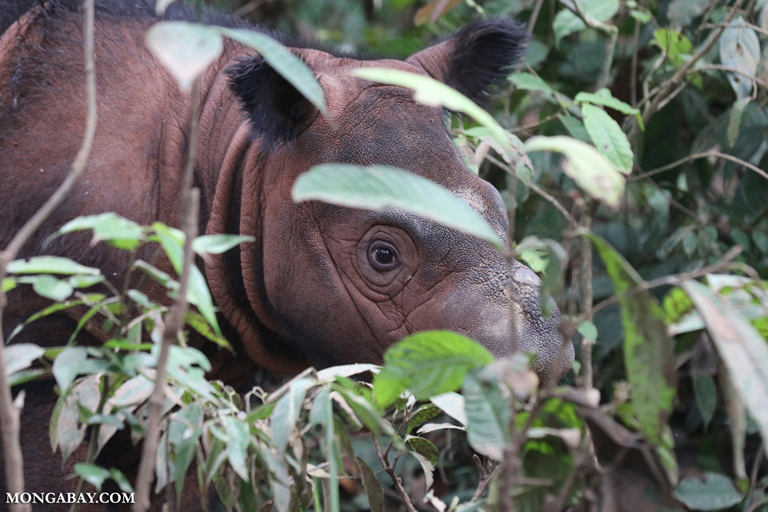Sumatran rhinos are among the rarest and most endangered animals on earth. The species’ wild population numbers no more than 80, fragmented into small sub-populations in Sumatra and Borneo. Another nine live in captivity in Indonesia and Malaysia, where researchers hope they can contribute to the long-term survival of their species.
Sumatran rhinos are on the brink of extinction but are also the subject of increasingly intensive efforts to reverse their decline. In September 2018, a coalition of international conservation organizations announced the official launch of Sumatran Rhino Rescue, an effort to support the Indonesian government’s captive breeding program. Since then, a rhino has been successfully captured, the network of rhino sanctuaries in Indonesia is expanding, and efforts to better survey and protect surviving wild populations are underway.

At this critical juncture, Mongabay is launching a special reporting initiative aimed at raising awareness about the Sumatran rhino and chronicling successes and setbacks in local and international efforts to save the species from extinction.
Topics of interest include, but are not limited to: threats facing the Sumatran rhinos; news and analysis relating to conservation efforts; new research about the species; the impact of local, regional and institutional politics on Sumatran rhino conservation; interviews with officials, experts and community members connected to rhino conservation efforts; and historical and cultural perspectives on the Sumatran rhino.
In addition to print stories, we are seeking fully produced short documentaries (3+ minutes) as well as video clips Mongabay can edit in-house for use on social media. Videos should include interviews with experts and/or local people involved in or affected by conservation efforts, as well as contextual footage such as images of wildlife, scenery, and conservationists at work.
Completed print stories will be published in English on Mongabay.com under an open Creative Commons license that allows for sharing, translation, and re-posting. More information on Mongabay’s editorial standards and practice can be found here.
Authors of print stories will be expected to provide 5-10 publishable photos (either original, provided by those interviewed, or found free of copyright restrictions online) to accompany their articles, along with captions and photo credits.
Mongabay will negotiate fees and contracts for video and print submissions on a per-story basis, depending on the journalist’s experience and the complexity of the reporting. Funds are available to defray local/regional travel costs.
How to submit your story pitch
To send Mongabay a pitch, please be prepared to also share your resume/portfolio along with three samples of your work. The story pitch should be roughly 500 words in length and include a title for the project. Viable pitches will clearly explain the specific subject you would like to write about in detail, your approach to covering it, describe a few potential sources, and how it is significant to the future of the species. If you are proposing a story that is led by video, please indicate that and include a short description of your video idea. Pitches for video-led stories should also include an expected shot list and interviews.
Please review the complete guidelines on what to include in your pitch here: https://mongabay.org/programs/news/opportunities/
Please submit your pitch here along with your journalism resume and three clips.
All pitches must be submitted in English, and all final reporting will be published first in English. However, Indonesian-language journalists are encouraged to pitch stories in Bahasa Indonesia to Rahmadi Rahmad, one of our Indonesian editors.
Pitches will be considered on a rolling basis, or when our budget is disbursed.